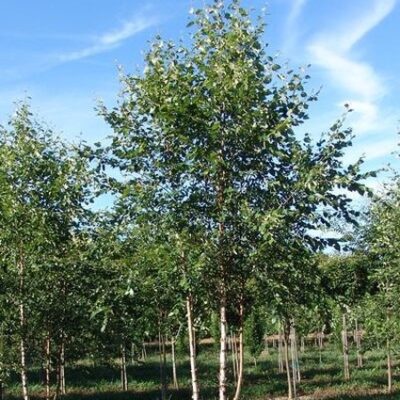Garden Plant: Dura Heat River Birch
Product Description: Dura Heat River Birch

Fast Growing, Lovely Dura Heat River Birch
- Fast Growing Shade Tree
- Attractive Bark Exfoliates to Creamy White, Pink, and Cinnamon
- Green Leaves Turn Butter Yellow in Fall
- Great Fall Color
- Heat Tolerant
- Ice Resistant
- Urban Tolerant
- Birch Trees that Love the Heat
- More Refined, Medium Sized
- Deer Don’t Prefer This Tree
- Better Pest and Disease Resistance
- Non-Toxic Trees Safe to Use Near Horses and Livestock
People just love these beautiful trees! One of the country’s most popular ornamental, deciduous trees, Dura Heat (Betula nigra \’BNMTf’) is a real standout specimen. The unique bark is light-colored and offers an unmatched performance over any other similar tree.
Dura Heat is a wonderful heat tolerant selection of River Birch that has better insect and disease resistance than the species. It is a Birch that actually likes the heat and can be grown up into Zone 9, as long as it does not get too dry.
One of the best attributes is the attractive, creamy white bark which peels and exfoliates to expose the pinkish, cinnamon colors of the inner bark. Dura Heat’s tree bark adds welcome texture to your landscape.
The leaves are far superior to the species with a deep green summer color, and outstanding butter-yellow fall color. Dura Heat has a denser, greener foliage canopy than other Birch and is quite tolerant of hot temperatures, as the name implies. Gentle rustling sounds and kinetic movement from the leaves fluttering in the slightest breeze will refresh you and your guests, even on the hottest summer day.
Dura Heat stands up to leaf spot. Give it full sun with moist soil, or add water as needed. Hardy for most all U. S. climate zones, it is fast-growing, well-forked, wind and ice-resistant.
Don’t miss your chance to own this spectacular tree! Order Dura Heat River Birch from us today.
How to Use Dura Heat River Birch in the Landscape
This urban savvy Birch is fantastic when used in natural, informal groups of odd numbers. They make excellent windbreaks. People often include them in shelterbelts because they grow fast and are easy to grow.
Use as a single accent tree in the lawn. They work beautifully to fill tall and narrow spaces.
The refined, pyramidal form of Dura Heat is fantastic as a single stem plant. It’s wonderful when grown in multiple stem clump form, also. Try using a mix of both forms for a very natural look.
Create a grouping as a focal point where You’ll see them from inside your house or on your deck as a vista or view. Plant a loose triangle of three trees 15 – 20 feet apart on center. You’ll measure from the center of one to the center of the next.
Mulch underneath your trees and underplant with Maidenhair Ferns or Purple Wintercreeper, as many professional landscapers do to create incredible visual impact and effect.
Use them in woodland or wetland areas and around man-made water features. Include Dura Heat on the edge of a planned Rain Garden in a natural low spot. You’ll capture potentially polluted water runoff from roofs and streets. Plants will filter the water before it reaches storm sewers and local waterways.
Many like to use Dura Heat Birch as street trees too. They are very adaptable to many urban areas, as long as they don’t get too dry.
Pro Plant Tips for Care
These River Birches love a moist, slightly acidic soil, but do adapt to many landscape situations as long as you keep them watered. Standing water can be problematic for their root systems, so if you will use them in a wetter area, mound up when planting by adding 18 – 24 of soil to the lay of the land. Plant in that mound to protect the root crown from suffocating from lack of oxygen.
Dura Heat can be grown in climates across the United States. Give it a moderate amount of regular water when young, and during extended periods of drought. If they don’t get enough water, You’ll start seeing leaves drop during summer. Give them adequate water for best performance.
In fall, be sure to give water to build up its store of moisture. Attention to the watering detail is important and if the plants get very dry, especially going into winter, they could see some damage. If you are in an area that is very dry in winter and the ground may not be frozen, Birch will also benefit from winter watering if needed.
Prune later in the spring, just after the plant begins to leaf out to eliminate the late winter sap dripping out of the pruning cuts. Remove crossing branches as needed. Remove lower limbs to raise the height of the canopy as you prefer.
Fertilize with an organic, slow release formula in early spring. Keep the plants mulched well over the root system to keep them cool and suppress weeds.
Enjoy this beautiful tree. Order yours today, if you see it in stock on the site. We sell out of this desirable variety each year!


